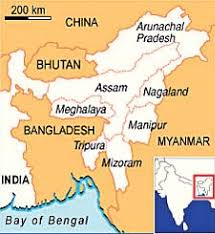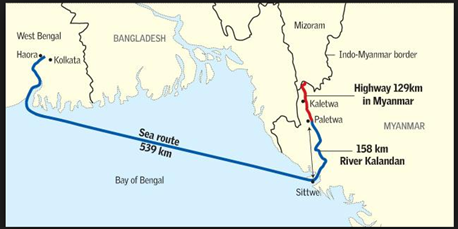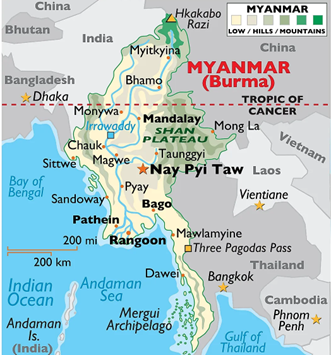Description

Copyright infringement not intended
Context: Myanmar’s military government hosted the first high-level regional meeting since the Army took power last year with China’s Foreign Minister Wang Yi and counterparts from Mekong Delta nations.
Details:
- China’s Foreign Minister met with his colleagues from Myanmar, Laos, Thailand, Cambodia and Vietnam at the Lancang-Mekong Cooperation group meeting held under the theme “Solidarity for Peace and Prosperity” in the central city of Bagan, a UNESCO World Heritage site.
- The grouping is a Chinese-led initiative that includes the countries of the Mekong Delta, a potential source of regional tensions due to an increasing number of hydroelectric projects that are altering the flow and raising concerns of ecological damage.
- China has built 10 dams along the upper stretch of the Mekong, the part it calls the Lancang.
- China has been criticised for the dams upstream on the Mekong river which affect water levels and downstream fisheries that are important to several Southeast Asian nations’ economies.
- China is Myanmar’s biggest trading partner and an old ally.
- Beijing has invested billions of dollars in Myanmar’s mines, oil and gas pipelines and other infrastructure and is its major arms supplier, together like Russia. Many in Myanmar suspect China of supporting the military takeover.
Lancang-Mekong Cooperation:
- Lancang-Mekong Cooperation is a multilateral format established in 2016 for cooperation between the riparian states of the Lancang River and Mekong River.
- The Lancang is the part of the Mekong that flows through China. Cambodia, Laos, Myanmar, Vietnam and Thailand are five downstream countries of the Mekong River.
- The central purpose of the format is for China to manage water flow from its hydropower dams with the other riparian states.
- China has built seven mega-dams on the Lancang-Mekong and according to the US-based NGO International Rivers 20 are under construction or planned in Yunnan, Tibet and Qinghai.
- LMC Special Fund: A fund was created in 2016 to aid in small and medium-sized projects by the Lancang-Mekong countries
India-Myanmar’s Relations:
“Myanmar is India’s gateway to Southeast Asia, India is Myanmar’s gateway to South Asia.”
Why Myanmar Should Matter to India
- Myanmar is only country that sits at the intersection of India’s “Neighborhood First” policy and “Act East” policy.
- Myanmar is an essential element in India’s practice of regional diplomacy in the Indo-Pacific, and serves as a land bridge to connect South Asia and Southeast Asia.
- Myanmar is an important member of the Bay of Bengal Initiative for Multi-Sectoral Technical and Economic Cooperation (BIMSTEC), a multilateral subregional organization that is committed to fostering bilateral or regional cooperation among Bay of Bengal countries.
- To elevate its “Made in India” arms industry, India has identified Myanmar as key to increasing its military exports.
- Myanmar is geopolitically significantto India as it stands at the center of the India-Southeast Asia geography.

Copyright infringement is not intended

Copyright infringement is not intended
- Myanmar is the only Southeast Asian country that shares a land borderwith northeastern India, stretching some 1,624 kilometers. The neighbors also share a 725-km maritime boundary in the Bay of Bengal.
Measures taken to improve ties:
- It was one of only two Southeast Asian countries invited to attend the swearing-in of Indian Prime MinisterNarendra Modi after he won re-election in May 2019.
- Facilitating connectivityis central to improving India-Myanmar economic relations. India regards Myanmar as a gateway to link up to the rest of Southeast Asia, and invested in ASEAN-wide infrastructural projects that are able to boost trade in the ASEAN-India Free Trade Area.
- Infrastructure projects:
- The India-Myanmar-Thailand Trilateral Highway and Kaladan Multi-Modal Transit Transport (KMMTT), to connect the eastern Indian seaport of Kolkata with the Sittwe deep-water port in Myanmar’s Rakhine state by sea.

Copyright infringement is not intended
- Sittwe port:
- As part of its policy for the Indian Ocean called Security and Growth for All in the Region (SAGAR),central to which is “port-led development,” India developed the Sittwe port in Myanmar’s Rakhine state.
- This port, which sits on the Bay of Bengal, serves as a critical node of the KMMTT initiative to connect southwestern Myanmar to northeastern India by creating a multi-modal trinary of sea, river and road transport corridor to boost interconnectivity.
- India’s long-term strategic goal is to create a Special Economic Zone surrounding the Sittwe port.
- The Sittwe port is meant to be India’s answer to the Chinese-fronted Kyaukpyu port, which is intended to cement China’s geostrategic footprint in Rakhine.
- India has been providing humanitarian reliefeven while deporting Rohingya refugees from India for security reasons, provoking the UN’s ire.
Challenges in India-Myanmar relations:
- China Factor: Beijing’s bidding into Myanmar regional affairs. Myanmar is inevitability a “kingmaker” in Sino-Indian relations.
- Trade deficit:With a total bilateral trade of $2 billion, India’s economic engagement with Myanmar lags behind China. Myanmar is vital to fulfilling India’s ambition to become a $5 trillion economy by 2024. India’s withdrawal from Regional Comprehensive Economic Partnership can further increase this trade gap.
Strengths of India-Myanmar relations:
- It is the only Southeast Asian countrythat has a separate bureaucratic division (shared with Bangladesh) in India’s External Affairs Ministry, testifying to the continued importance of Myanmar to India’s current foreign policy.
- Operation Sunshine 1 and 2:The Indian and Myanmar armies have carried out two joint military operations, Operation Sunshine 1 and 2, to fight militants along the borders of Myanmar’s Rakhine state, which borders the northeastern Indian states of Arunachal Pradesh, Nagaland, Manipur, and Mizoram.
- IMBAX-2017 and IMBEX 2018-19: Seeing that Myanmar is critical to its national security interests, India provides military training and conducts joint military exercises with the Myanmar Army like the India-Myanmar Bilateral Military Exercise (IMBAX-2017 and IMBEX 2018-19), by which India had trained the Myanmar Army to be able to participate in UN Peacekeeping Operations.
- Defense Cooperation Agreement: To deepen their defense relations, India and Myanmar signed a landmark defense cooperation agreement in July 2019.
- IMNEX-18:Realizing the growing importance of the Bay of Bengal, the navies of both India and Myanmar conducted a historic bilateral naval exercise, IMNEX-18, in 2018. India also invited the Myanmar Army to participate in the India-led multilateral Milan naval exercise that occurs biennially in the Andaman and Nicobar Islands.
- Military purchases: Myanmar bought India’s first locally-produced anti-submarine torpedo, called TAL Shyena, a diesel-electric Kilo-class submarine, INS Sindhuvir.
- Cultural diplomacy: “Buddhist Circuit” initiative, which seeks to double foreign tourist arrivals and revenue by connecting ancient Buddhist heritage sites across different states in India, should resonate with Buddhist-majority Myanmar.
Way forward:
- Security Cooperation: For economic relations to improve, India and Myanmar must boost their security cooperation at the border. The more secure the border is, the greater the economic activity will be.
- For example: Part of the reason why the KMMTT has faced delays is that the route of the project traverses a warzone in Rakhine state, where a battle rages on between the Myanmar Army and the Arakan Army rebels on the one hand, and on the other, the Arakan Rohingya Salvation Army. Insurgents from India’s Nagaland have also disrupted the completion of the KMMTT project.
- Handling Rohingya issue with care:Myanmar’s geostrategic importance to India has meant that Delhi did not take a hardline approach on Naypyidaw vis-à-vis the Rohingya issue, even keeping its distance when Myanmar was hauled into the International Court of Justice over accusations of Rohingya genocide. India, which has a Hindu majority, will need to perform a balancing act between Muslim-majority Bangladesh and Buddhist-majority Myanmar as far as the Rohingya issue is concerned. The quicker the Rohingya issue is resolved, the easier it will be for India to manage its relations with Myanmar and Bangladesh, focusing instead more on bilateral and subregional economic cooperation.
- India’s Buddhist diplomacywould bolster its tourist industry and could build up India’s diplomatic reservoir of goodwill and trust with Buddhist-majority countries such as Myanmar.
Conclusion:
- Potential in India-Myanmar relations has to be prioritized by both countries, and bilateral commitments translated should bear some practical outcomes. However, the responsibility remains on India as to how far and deep it is prepared to nurture its relations with Myanmar, knowing full well that Naypyidaw will matter much to Delhi in the next decade, not least if India wants to augment its standing as a regional power in the Indo-Pacific.
- India-Myanmar ties are on the cusp of a remarkable transformation. The moment is opportune and the atmosphere is conducive for the governments of India and Myanmar to intensify efforts toward making India-Myanmar relations profoundly significant in each other’s foreign policy.
Geography of Myanmar
- Myanmar (also known as Burma) is the northwesternmost country of mainland Southeast Asia located on the Indochinese peninsula.
- With an area of 261,228 sq mi (676,578 sq km), it is the second largest country in Southeast Asia and the largest on mainland Southeast Asia.

Copyright infringement is not intended
- Myanmar lies along the Indian and Eurasian Plates, to the southeast of the Tibetan Plateau.
- The country is nestled between several mountain ranges with the Arakan Mountains on the west and the Shan Plateau dominating the east. It includes more than 16 islands and the Mergui Archipelago.
Border countries:
- Bangladesh: 271 kilometres (168 mi), India:1,468 kilometres (912 mi), China: 2,129 kilometres (1,323 mi), Laos: 238 kilometres (148 mi), Thailand: 2,416 kilometres (1,501 mi).
Climate:
- Tropical monsoon in the lowlands below 1,000 m (3,281 ft); cloudy, rainy, hot, humid summers (southwest monsoon, June to September); less cloudy, scant rainfall, mild temperatures, lower humidity during winter (northeast monsoon, December to April).
Rivers:
- The Irrawaddy, the main river of Burma, flows from north to south through the Central Burma Basin and ends in a wide delta. The Mekong river runs from the Tibetan Plateau through China's Yunnan and northeastern Burma into Laos.
- In the east the Salween and the Sittaung River run along the western side of the Shan Hills and the northern end of the Dawna Range. The Salween begins in China, where it is called the Nu River.
- In the narrow southeastern part of Burma, the Ye, Heinze, Dawei (Tavoy), Great Tenasserim (Tanintharyi) and the Lenya rivers are relatively short and flow into the Andaman Sea. Further south the Kraburi River forms the southern border between Thailand and Burma.
https://epaper.thehindu.com/Home/ShareArticle?OrgId=GJAA0F9T0.1&imageview=0
1.png)


















